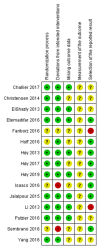Surgical Treatments for Lumbar Spine Diseases (TLIF vs. Other Surgical Techniques): A Systematic Review and Meta-Analysis
- PMID: 35360425
- PMCID: PMC8964266
- DOI: 10.3389/fsurg.2022.829469
Surgical Treatments for Lumbar Spine Diseases (TLIF vs. Other Surgical Techniques): A Systematic Review and Meta-Analysis
Abstract
Objective: The purpose of this study is to compare fusion rate, clinical outcomes, complications among transforaminal lumbar interbody fusion (TLIF), and other techniques for lumbar spine diseases.
Design: This is a systematic review and meta-analysis.
Data sources: PubMed, EMBASE, Scopus, Web of Science, and CENTRAL databases were searched from January 2013 through December 2019.
Eligibility criteria for selecting studies: Randomized controlled trials (RCTs) that compare lumbar interbody fusion with posterolateral fusion (PLF) and/or other lumbar interbody fusion were included for the review.
Data extraction and synthesis: Two independent reviewers extracted relevant data and assessed the risk of bias. Meta-analysis was performed using a random-effects model. Pooled risk ratio (RR) or mean difference (MD) with a 95% confidence interval of fusion rate, clinical outcomes, and complications in TLIF and other techniques for lumbar spinal diseases.
Results: Of 3,682 potential studies, 15 RCTs (915 patients) were included in the meta-analysis. Compared to other surgical techniques, TLIF had slightly lower fusion rate [RR = 0.84 (95% CI = 0.72-0.97), p = 0.02, I 2 = 0.0%] at 1-year follow-up whereas there was no difference on fusion rate at 2-year follow-up [RR = 1.06 (95% CI = 0.96-1.18), p = 0.27, I 2 = 69.0%]. The estimated RR of total adverse events [RR = 0.90 (95% CI = 0.59-1.38), p = 0.63, I 2 = 0.0%] was similar to no fusion, PLF, PLIF, and XLIF groups, and revision rate [RR = 0.78 (95% CI = 0.34-1.79), p = 0.56, I 2 = 39.0%] was similar to PLF and XLIF groups. TLIF had approximately half an hour more operative time than other techniques (no fusion, ALIF, PLF, PLIF, XLIF) [MD = 31.88 (95% CI = 5.33-58.44), p = 0.02, I 2 = 92.0%]. There was no significant difference between TLIF and other techniques in terms of blood loss (no fusion, PLIF, PLF) and clinical outcomes (PLF).
Conclusions: Besides fusion rate at 1-year follow-up and operative time, TLIF has a similar fusion rate, clinical outcomes, parameters concerning operation and complications to no fusion, PLF, and other interbody fusion (PLIF, ALIF, XLIF).
Systematic review registration: https://www.crd.york.ac.uk/prospero/, identifier: CRD42020186858.
Keywords: lumbar disease; meta-analysis; spine fusion surgery; spondylolisthesis; transforaminal lumbar interbody fusion.
Copyright © 2022 Wasinpongwanich, Nopsopon and Pongpirul.
Conflict of interest statement
The authors declare that the research was conducted in the absence of any commercial or financial relationships that could be construed as a potential conflict of interest.
Figures




References
-
- Harms J, Rolinger H. Die operative behandlung der spondylolisthese durch dorsale aufrichtung und ventrale verblockung [A one-stager procedure in operative treatment of spondylolistheses: dorsal traction-reposition and anterior fusion (author's transl)]. Z Orthop Ihre Grenzgeb. (1982) 120:343–7. 10.1055/s-2008-1051624 - DOI - PubMed
-
- Foley KT, Lefkowitz MA. Advances in minimally invasive spine surgery. Clin Neurosurg. (2002) 49:499–517. - PubMed
Publication types
LinkOut - more resources
Full Text Sources

